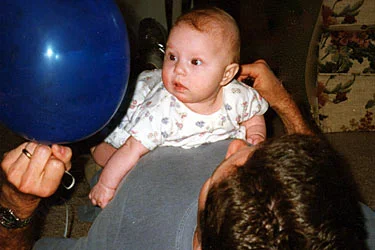Any time your baby is supervised and positioned on the stomach for play, that is considered tummy time! The American Academy of Pediatrics formally recommends that parents provide babies with supervised playtime on the stomach to promote growth and development and prevent flat spots from forming on the head.
My research has revealed that approximately 50% of parents report that their infants do not tolerate being positioned on the stomach for play! Parents consistently tell me how their infants fuss and cry with every attempt at tummy time. I can hear the frustration in their voices. Yet there is good news! I know that with time and a few simple yet effective techniques, any infant can learn to tolerate tummy time.
There is a solution to the problem, because I know how to introduce tummy time without making a parents’ and baby’s life miserable. This Post provides useful tips and stimulating activities to introduce tummy time and to increase your infant’s tolerance tummy time.
An important reminder, once your baby starts participating in tummy time, always remember, you should absolutely never leave his side! In this world of distractions, it is likely that a phone will ring, or someone may call you in another room, but NEVER leave your baby unattended while in the tummy time position! There is always the risk that baby could fall asleep, and being on the stomach puts him at an increased risk of SIDS. So, never leave your baby’s side and give him your undivided attention during every second of tummy time!
Benefits of Tummy Time
In one year, all across America, approximately 2,000 infants die of Sudden Infant Death Syndrome, also known as SIDS. Before 1992, most babies in the U.S. slept on their stomachs. However, when researchers discovered that infants were much more likely to be found on their stomachs than on their backs when they had died of SIDS, the American Academy of Pediatrics (AAP) recommended that all babies be placed to sleep on their backs or sides to reduce the risk of SIDS.
Later, the side position was eliminated as a recommendation because infants can roll from their sides to their stomachs while sleeping. Since the original sleep position recommendation was made by the AAP in 1992, 50% fewer infants have died from SIDS. Putting babies to sleep on their backs has turned out to be a simple and effective way to reduce the risk of Sudden Infant Death Syndrome!
Several years after the AAP made their “Back to Sleep” recommendation, pediatricians and therapists began to notice increased incidences of flat spots forming on the heads of infants. They also noticed an increase in the number of infants with mild delays in gross motor skills, such as rolling over and pulling up.
Spending time on the stomach provides opportunities for the development of important muscle groups needed for those motor skills, and it seemed that parents weren’t positioning infants on their stomachs during the waking hours due to a fear of SIDS.
Parents were misinterpreting the AAP’s recommendation and were fearful that SIDS might occur while the infant was awake and positioned on the stomach. As a clarification, in 1996, the American Academy of Pediatrics made another formal recommendation, stating that parents provide babies with supervised playtime on the stomach to promote growth and development and prevent flat spots from forming on the head. Hence, the term tummy time resulted!
Read more: 10 Reasons To Love Tummy Time!
Quick Tummy Time Tips
Start Early
Believe it or not, you can begin exposing your baby to tummy time while you both are still in the hospital. The earlier you start, the more likely that your infant will accept the stomach as a natural position. Before the umbilical cord has fallen off and before baby has good head control, you can position your newborn on your stomach or chest while you lie in a reclined position on a chair, bed, or the floor. This is the perfect opportunity to socialize with baby by encouraging eye contact. You can even rock your body from side to side to incorporate some movement while baby is positioned like this. This can be a great way to calm your infant if he doesn’t seem to be too crazy about the position.
Start Gradually
Your baby may only tolerate 15 seconds of tummy time on the first attempt. That is fine! You can add 15 to 30 seconds each tummy time session. The goal is to eventually work up to at least 30 minutes, but this does not have to happen all at once. Remember to always stop if your infant begins to cry in protest. Take a break, and try again later!
Bolster Time
One way to make tummy time feel less like work is to make a small bolster by rolling up a thin towel or blanket and place this under baby’s chest. Position baby’s arms over the roll with his hands reaching out in front of the roll. If baby’s chin drops, it should still be positioned slightly in front of the roll, and so that his mouth and nose still get plenty of air. There is also a commercially available product, called a Boppy nursing pillow that does a nice job providing support during tummy time.
Lap Time
Position baby across your lap long ways while providing head support. Remember to keep baby’s head aligned with his body and if baby falls asleep in that position, immediately transfer him to the bed (lying on his back).
Distract Baby
If your baby dislikes being on her stomach, remember this: distract, distract, distract! Do whatever it takes to get your baby’s mind off of her position. You can play music, sing, shake toys, and clap your hands, keeping baby occupied until you gradually stretch the seconds into minutes.
Face to Face Time
Lie down on the floor facing your baby during tummy time. Stay on his eye level and talk to him or read to him. Remember, your voice and expressions should be animated!
Have a Schedule
Having a schedule makes is easier to remember tummy time, and your baby will likely come to anticipate the routine. Just remember to never leave your baby’s side during tummy time!





